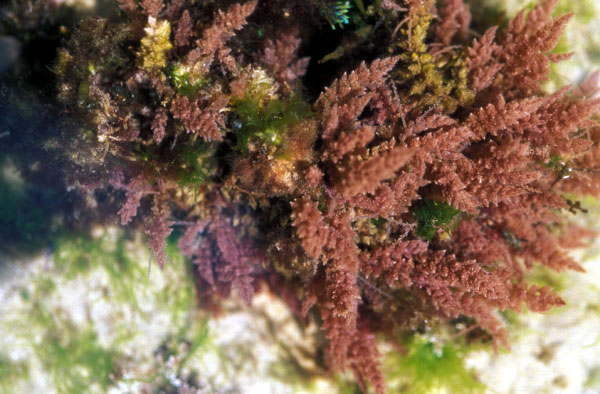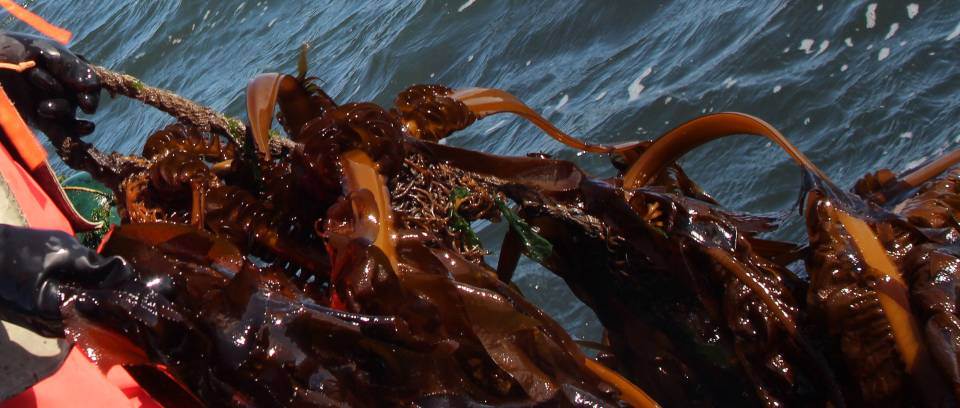To evaluate the potential of using Corn Dried Distiller's Grain with Soluble (DDGS) as a potential alternative ingredient in feeds for the Pacific White Shrimp, Litopenaeus vannmei.
Digital library
-
-
Rates of inorganic nitrogen uptake by three Northeast US and three Asian species of Porphyra were compared in short-term incubations to evaluate potential for longer term and larger scale examination of bioremediation of nutrient-loaded effluents from finfish aquaculture facilities. The effects of nitrogen (N) species and concentration, temperature, acclimation history, and irradiance were investigated. Uptake rates increased ca. nine-fold from 20 to 150 μM N. Nitrate and ammonium uptake occurred at similar rates. Irradiance had a strong effect, with uptake at 40 μmol photons m−2 s−1only 55% of uptake at 150 μmol photons m−2 s−1. N-replete tissue took up inorganic nitrogen at rates that averaged only 60% of nutrient-deprived tissue. Although there were species (P. amplissima > (P. purpurea = P. umbilicalis)) and temperature effects (10 C>5 C>15 C), interactions among factors indicated that individual species be considered separately. Overall, P. amplissima was the best Northeast US candidate. It took up ammonium at faster rates than other local species at 10 and 15 C, two temperatures that fall within the expected range of industrial conditions for finfish operations.
-
Experimental field cultivation of the agar yielding red alga Gracilaria edulis was carried out at Valinokkam Bay from May 1992 to April 1994 at 1.5 to 3.0 m depths using 2x2 m size coir rope nets fabricated with 1" thick coir ropes and 1" thick long line coir ropes. The seedlings cultured on nets and long line ropes during May to December in 1992 and 1993 degenerated due to sedimentation and low light intensity. The growth of G. edulis seedlings from January to April during 1993 and 1994 was good and reached harvestable size of 14.4 cm and 22.9 cm (mean length) after 45 and 90 days respectively. Harvest could not be made, as many of the grown up plants were grazed by fishes. Data collected on environmental and hydrological parameters from the culture site at fortnightly interval were correlated with the growth of cultured seaweed. The result obtained in this experiment is compared with the results on the experimental field cultivation of G.edulis carried out in the near shore areas of Mandapam and lagoon of Minicoy and Lakshadweep.
-
In India seaweeds are used for the production of phytochemicals namely agar-agar and sodium alginate. The red seaweeds Gelidiella acerosa, Gracilaria edulis and G. crassa are used as raw material for agar-agar.
-
The red alga Hpea valentiae (Turn.) Mont. is one of the carrageenan producing seaweeds. Experiment was canied out at Minicoy Lagoon of Lakshadweep during 1998 to fmd out the feasibility of farming of H. valentiae. Two sites were selected in the intertidal zone of Minicoy lagoon, namely South end and Fisheries Jetty and farming was carried out in three seasons @re monsoon, monsoon and post monsoon). Single line bottom coir rope method was adopted for farming. The vegetative fragments of H. valentiae collected from wild were inserted between the twists of long coir ropes. Both ends of the ropes were tied to the coral stones and introduced in the intertidal waters of the lagoon. During the first harvest maximum yield of 6 fold increase was obtained in 37 days and in the second harvest during monsoon months 25 fold increase was recorded in 40 days. Large scale farming of H. valentiae without causing any damage to the lagoon ecosystem by adopting single bottom coir rope method may be taken up by the fIshmen during the lean fishing season.
-
Species of Gracilaria from Gulf of Mannar were analyzed for their fatty acid composition. The major fatty acids such as myristic acid, myristoleic acid, palmatic acid, palmitoleic acid, stearic acid, oleic acid and linoleic acid were analyzed by gas liquid chromatography. The qualitative and the quantitative distribution of above fatty acids exhibited wide variation among the species of different habitat. The fatty acid content of the species collected from the same locality also showed quantitative variation depending on their distribution and the availability of light intensity to the particular species.
-
Consequences of congeneric quantitative variation in secondary metabolites of seaweeds on diet specificity and host association in specialist marine her- bivores have received little attention. We investigated quantitative variation in caulerpenyne and oxytoxin 1 in 7 species of green seaweeds from the genus Caulerpa, along with the feeding preferences and host associations of 4 co-occurring sacoglossan molluscs. C. taxifolia and C. sertularioides contained high concen- trations of metabolites and were preferred least by all herbivores. Algae with intermediate metabolite con- centrations (C. racemosa, C. serrulata, and C. cupres- soides) were preferred by Elysia tomentosa and Lo- biger viridis. Oxynoe viridis and Stiliger smaragdinus had strong preferences for different low concentration Caulerpa species (C. racemosa var. laetevirens and C. lentillifera), suggesting not all feeding preferences are based exclusively on the major metabolites. In situ host associations of L. viridis and S. smaragdinus mirrored their feeding preferences, but this was not the case for E. tomentosa. Furthermore, those algal species with the highest and lowest metabolite concentrations had the lowest overall densities of sacoglossans. The results im- ply that the direct influence of quantitative variation in Caulerpa chemistry may only be limited to host associa- tions in some sacoglossans. However, feeding pressure from multiple herbivore species with unique prefer- ences could still contribute to variation in chemical defence amongst congeneric algae.
-
Brown kelp macroalgae — the strange, foul-smelling seaweed so often found washed up on the Pacific Northwest’s volcanic sand beaches — could ultimately offer an almost unlimited global supply of commercial-quality ethanol or biomethane.
-
A significant challenge to the expansion of aquaculture production is controlling the outbreak of disease. Many farmers who experience the potential loss of stock from disease may choose to use chemotherapeutic agents to minimize their loss. It is generally understood that a disease in aquaculture is a combination of the health of the animal, the condition of the environment and the presence of a pathogen. From this concept there are a number of precautionary measures that farmers may practice to minimize disease outbreaks. The principles of Hazard Analysis Critical Control Point (HACCP) may be useful risk management tools to reduce pathogens, animal stress and the need for chemotherapeutic agents to control disease outbreaks on the farm.
-
The seaweeds are a diverse group of large marine macroalgae that are as important to the marine world as land plants are to our terrestrial world. Seaweeds were the precursors to land plants, and like land plants, they are critical primary producers, forming living links between the inorganic and the organic world, using photosynthesis to convert CO2 and nutrients into living biomass. These primary producers support and encourage other marine life through the production of oxygen, contribution to marine food webs, and by providing structure and habitat for refuge, breeding, and nursery grounds for fish and invertebrates. Seaweeds are an important resource for humans. Coastal peoples have always utilized seaweeds for food, minerals, medicine, fertilizer and fodder, and these sea-plants continue to provide for an everincreasing world population. A multi-billion dollar industry worldwide, seaweeds are consumed as nutritious sea vegetables, processed to extract valuable phycocolloids including agar, carrageenan, and alginate, and utilized in the agricultural industries for animal fodder or plant fertilizers.





